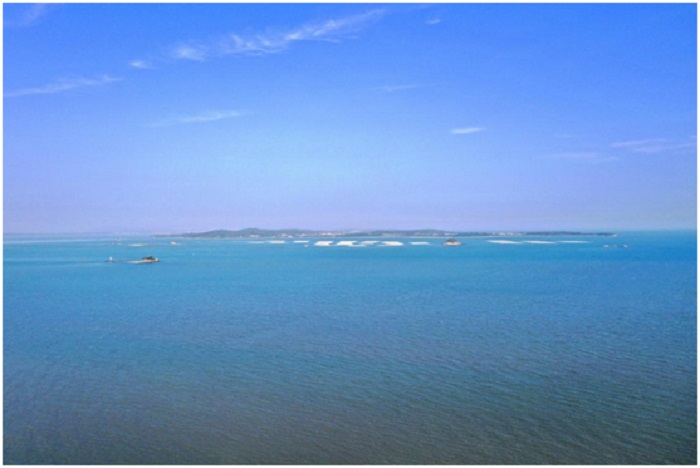



Building China into a strong maritime country is a major strategic task for realizing the great rejuvenation of the Chinese nation, said Chinese President Xi Jinping during a recent inspection tour to the Sanya Oceanographic Institution of the Ocean University of China, south China’s Hainan province.
China is a major maritime country whose mainland coastline measures approximately 18,000 kilometers and the island coastline 14,000 kilometers. It also boasts an offshore territory of more than three million square kilometers and abundant marine resources.
In recent years, the country has vigorously developed its marine resources to accelerate the building of world-class ports and modern marine industries, propelling rapid development of the marine equipment manufacturing, marine transport, marine new energy and coastal tourism sectors. As a result, the country’s marine economy has been constantly expanded. Last year, China’s gross ocean product topped 9 trillion yuan (about $1.41 trillion) for the first time.
Advanced marine technology is a powerful factor driving the building of a strong maritime country, and China has been making remarkable progress in this regard though it is a late starter.
China has transformed itself from a follower to a leader in maritime technology after developing a number of significant pieces of marine equipment.
For instance, it has deployed the Deep Sea No.1, the country’s first independently operated ultra-deepwater gas field, in the seawaters in Lingshui, Hainan province. It is also supplying 95 percent of the parts on its independently developed 4,500-meter deep-sea manned submersible Shenhai Yongshi (Deep Sea Warrior). Besides, the country’s homegrown deep-sea manned submersible Fendouzhe (Striver) has dived to a depth of 10,909 meters in the Mariana Trench.
According to a 2020 report, China ranked 4th globally in terms marine technology innovation.
To build a strong maritime country, China is working to protect marine ecology and striving for a harmonious relationship between mankind and ocean.
The country is constantly improving the management models for marine ecology and implementing major projects such as “Blue Bay” and “Ecological Island and Reef” in a coordinated manner. Fruitful results have been achieved in marine ecological treatment.
As of the end of 2020, China had built 14 marine reserves and 67 marine parks at national level, as well as 52 nature reserves covered by mangrove forests. It is one of the few countries in the world that have witnessed a net increase in mangrove area.
At present, nearly 30 percent of the country’s offshore areas and 37 percent of mainland coastlines are protected under the strictest measures, and over 270 marine reserves at various levels have been established, totaling more than 12 million hectares.
The ocean, as the world’s largest carbon sink, produces around 70 percent of the oxygen on Earth and absorbs billions of tonnes of carbon dioxide each year. Currently, China is taking active actions to strive for its goal of carbon peak and neutrality, which drives coastal provinces to accelerate their exploration of the development of ocean carbon sink.
The ocean is a huge body water that covers about 71 percent of Earth’s surface. Over the past one thousand years, the Maritime Silk Road acted as both a cross-ocean trade channel and a platform of civilizational interactions. In Quanzhou, an important port along the Maritime Silk Road, People of different skin colors, faith and languages coexisted harmoniously. The Chinese people’s vision to build a peaceful and harmonious world has always been shining along the trade route.
President Xi once said that “The blue planet humans inhabit is not divided into islands by the oceans, but is connected by the oceans to form a community with a shared future, where people of all countries share weal and woe.”
Oceans are not only a natural bond connecting countries, but also a new type of exchange and cooperation platform under the changing international circumstances in today’s world. Countries should work as one to safeguard maritime peace and marine eco-environmental progress, properly handle disputes and collectively pursue prosperity so as to improve maritime well-being.
From proposing the building of the 21st Century Maritime Silk Road to improve maritime interconnectivity in 2013, to putting forward the important vision of a maritime community with a shared future in 2019, China has consistently prioritized common development and win-win cooperation.
China will fulfill its international responsibilities and obligations with a more proactive manner, earnestly practice the vision of building a maritime community with a shared future, provide more public products in the sphere of global maritime treatment, and work with the rest of the world to jointly build a maritime community with a shared future.


The Executive and members of the.


The Acting Director, FCT Directorate of.


President Bola Ahmed Tinubu has been.



Barely a month after resignation of.


An Abuja based Legal Practitioner, Osuagwu.



Convener of Equitable Remedy, Mrs. Magaret.


Contractors handling the contract for city.


Nigerian government may have concluded plans.


The Diplomatic Correspondents Association of Nigeria.


A rights group, “Follow Me Talk.
Leave a Comment